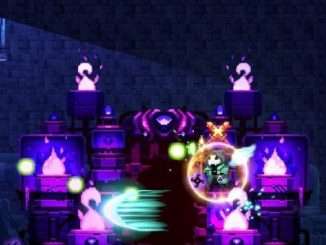
This is the first major title from Southpaw Games, which is an indie developer based in South Korea. It’s one of many roguelikes out there but the big question is does it manage to stand out amongst the roguelike crowd? Let’s setup up how Skul: The Hero Slayer actually works along with dealing out a few tips to help beginners out.
Tips for Newplayers
What’s Rookie Mode?
As a roguelike, Skul: The Hero Slayer can be challenging. Beginners in the genre need not worry because there is sort of an easy feature in the options menu. Rookie Mode will reduce all damage taken by half. Skul: The Hero Slayer is one of many indie games that included an option like this. It’s a trend that will hopefully continue in order to make games more accessible to all types of gamers. Players can tell when the mode has been activated because of the logo at the bottom of the screen showcasing a skull with a pacifier in its mouth.
Understanding Doors
There are primarily three types of random doors players should be aware of in Skul: The Hero Slayer. This doesn’t count shop or boss doors, for example. Those are always set. Gilded doors stacked with treasure usually pay out big cash rewards at the exit. Sometimes there will be chests instead with rare items. Green doors engulfed with flames will reward players with skulls at the end.
Skulls are power-ups that change the titular Skul into new forms kind of like the abilities in the Mario franchise. Using the normal-looking gateways will give players a more balanced stage but offer fewer amazing rewards. Unless players are really hurting for HP, always use one of the two rarer doors.
Read Up On Skulls
Each Skull form change comes with several different properties. The look is one. The weapon is another. The assigned ability is third. Most importantly, there are secret skills to some classes as well. After acquiring a skull and transforming, players should jump into the menu and read up.
For example, the Living Armor form builds up energy in a separate meter whenever Skul takes or deals damage. Once filled, using any ability will result in an extra burst of fire damage. Knowing what a skull’s class is capable of is half the battle.
Dark Quartz Upgrades
Most roguelike games have some sort of currency in them that can help boost a character’s stats permanently. In Skul: The Hero Slayer they are called Dark Quartz. These can be brought to the witch in the castle in order to unlock Traits. There are some useful but ordinary Traits such as being able to deal more damage or gain more HP. Those may look tempting early on but wait for it. Players should instead invest 3,000 Dark Quartz into getting Reassemble. This Trait resurrects Skul with 30% HP one time on a run. It’ll take time to unlock but it will be worth the wait.
What to Buy in Subspace
Players will also collect gold during runs. This currency is only temporary and all gold will be lost upon death such is the case with many roguelikes. It can be used in a subspace shop area that appears in-between every few stages in a world. There are items that can grant perks, food to restore HP, a vendor that will gift players a skull in exchange for another, and a blacksmith that has abilities.
Unless players have some sort of boon equipped that heals HP, the food should be the first stop. After visiting the blacksmith for an extra ability. Anything else after that is fair game. Just don’t buy anything from the Dark Quartz trader who appears randomly. That’s a waste of precious cargo.
Take Out Spellcasters First
Most enemies will attack Skul with melee attacks. Those foes are technically stronger but they should be ignored if there is a spellcaster among the crowd. Early enemies players will encounter include tree monsters that can summon vines to appear beneath them.
This will be indicated by a red box, allowing players an ample amount of time to dodge out of the way. It’s also a good indicator that there is an ability user in the vicinity. Long-ranged opponents, such as bowmen, should also take top priority. This is a basic strategy that can be applied to many action RPG games of this nature but it still bears repeating for Skul: The Hero Slayer.
What Saves After Quitting?
There is no way to save progress in the middle of a run. If players make it a few rooms into a dungeon and then decide to quit, they will be transported back to the castle upon their next startup. This is typical for roguelikes. However, that doesn’t mean data will be completely erased.
Dark Quartz, for example, will carry over. The only thing lost then is progress in the world. Before starting a run players should make sure they have enough time to put in what could be a long session. There is always the suspend function on the various consoles as well. The best system to do this with is the Switch. That system fits the roguelike genre rather well for pick-up and play runs.





Be the first to comment